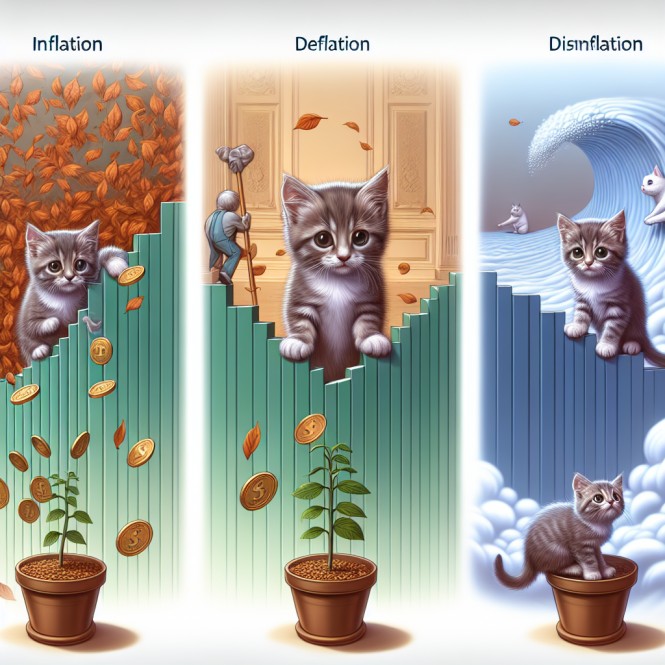Inflation vs Deflation vs Disinflation: Navigating for Success
Nov 26, 2024
Introduction: Inflation vs Deflation vs Disinflation Tango
In economics, few topics spark as much debate as inflation and deflation. These opposing forces frequently likened to a deadly tango, shape nations’ financial landscapes and fortunes. As the revered Greek philosopher Socrates wisely cautioned, “Whenever people are deceived and form opinions wide of the truth, it is clear that the error has slid into their minds through the medium of certain resemblances to that truth.” Indeed, in economics, few concepts are as misunderstood as inflation and deflation, and it is imperative to discern the truth from falsehoods.
This essay aims to unravel the complexities of inflation and deflation, highlighting their differences and offering insightful strategies for triumph through mass psychology, contrarian thinking, and technical analysis. We will also explore the lesser-known phenomenon of disinflation and discuss how investors and policymakers can successfully navigate these economic forces.
Inflation Unveiled
In this Inflation vs Deflation vs Disinflation analysis, we will break down each component, starting with inflation.
At its core, inflation refers to an increase in the money supply. This subtle yet profound distinction is often overlooked, as many economists and commentators equate inflation solely with a rise in the cost of goods. While price increases are a symptom of inflation, they do not define its essence. To understand inflation truly, we must look beyond semantic obfuscation and focus on the root cause – an excess of currency in the system.
Consider the insightful words of the ancient Greek philosopher Aristotle, who offered sage advice over two thousand years ago: “The end of labour is to gain leisure.” In economics, understanding inflation is the labour that leads to financial wisdom, enabling prudent decisions that safeguard our wealth.
Monetary Policy and Price Increases
When central banks engage in quantitative easing or, colloquially, “print money,” the laws of economics dictate that this surge in the money supply will eventually lead to a general price increase. The renowned economist Milton Friedman stated, “Inflation is always and everywhere a monetary phenomenon.” Thus, inflation is inherently linked to diluting a currency’s purchasing power.
The Tangible Impact on Individuals, Businesses, and Governments
Inflation’s reach extends broadly. As the money supply balloons, the purchasing power of each currency unit diminishes. In simpler terms, each dollar buys less, eroding the standard of living for those on fixed incomes or with limited financial means. Benjamin Franklin, one of the Founding Fathers of the United States, cautioned against the impact of inflation with his insightful words: “Beware of little expenses. A small leak will sink a great ship.” Inflation can gradually erode a nation’s purchasing power like a small leak, leading to significant economic consequences.
During periods of high inflation, consumers face difficult choices. Food, utilities, and transportation become more expensive, straining household budgets. Businesses also feel the pinch as production costs rise, squeezing profit margins. They are then faced with a dilemma – whether to absorb the higher costs or pass them on to consumers, potentially dampening demand for their products or services.
The insidious nature of inflation is aptly summed up by the American economist Herbert Stein, who remarked, “If something cannot go on forever, it will stop.” This statement underscores the unsustainable nature of unchecked inflation and the eventual economic upheaval it can cause.
Hyperinflation’s Specter: A Case Study from Weimar Germany
In extreme cases, inflation can spiral into hyperinflation, a destabilizing force that ravages economies. Weimar Germany in the 1920s provides a poignant example. During this period, prices doubled every few days, wages became worthless overnight, and people resorted to using wheelbarrows of cash to purchase essential goods. Hyperinflation is a stark reminder of the critical importance of maintaining monetary stability.
Deflation: The Opposing Force
Let’s focus on deflation, the counterforce in this economic tango. Proponents of deflation, or deflationists, argue that a decrease in the general price level benefits consumers and savers. They highlight the positive impact on debt, as the actual value decreases over time, benefiting borrowers. Additionally, deflationists contend that deflation increases the purchasing power of money, making goods and services more affordable.
However, as with most economic debates, the truth lies in the nuances. While mild deflation can benefit consumers and savers, a severe and prolonged deflationary spiral can have detrimental effects. The Great Depression is a stark example of how deflation can stifle economic growth, discourage investment, and trap an economy in a downward spiral.
Global Impact and Currency Dynamics
Today’s globalized world means economic events in one country can quickly reverberate across borders. The recent Eurozone sovereign debt crisis is a prime example of how economic troubles in one region can affect the stability of the entire eurozone. This crisis highlighted the shifting dynamics of global economic power and the impact of deflationary pressures on currency values.
As the Chinese philosopher Lao Tzu wisely advised, “Responding to change is easier than chasing change.” Recognizing and adapting to the shifting dynamics between inflation and deflation is crucial for investors and policymakers, enabling them to make informed decisions in global economics.
Disinflation: A Third Force
Disinflation is a critical yet misunderstood economic concept, referring to a slow inflation rate. This means that while prices continue to rise, they do so at a slower pace. Disinflation is typically triggered by a decrease in aggregate demand or an increase in supply. For example, during the Great Moderation in the United States from the mid-1980s until the 2007 financial crisis, disinflation was evident as macroeconomic volatility decreased and inflation rates gradually fell, mainly due to advancements in monetary policy and increased economic stability.
Although beneficial in preventing an overheated economy, if disinflation trends towards zero, it can edge towards deflation, potentially leading to a deflationary spiral where decreased price levels lead to reduced consumer spending and further economic slowdown. Thus, managing disinflation requires careful monetary policies to ensure it stabilizes rather than harms the economy.
Mass Psychology and Contrarian Thinking
Investors and policymakers must understand mass psychology and embrace contrarian thinking to triumph in the face of inflation, deflation, or disinflation. Market behaviour is often driven by herd mentality, and recognizing this can help identify potential turning points. Contrarian thinking involves going against the grain, buying when others are fearful, and selling when others are greedy, as famously advised by Warren Buffett.
For example, when consumers face higher prices during inflationary periods, a contrarian investor might seek opportunities in companies that can maintain profit margins through innovative cost-saving measures. Conversely, investing in companies that can stimulate demand through unique products or services could be strategic in a deflationary environment where consumers benefit from lower prices.
Technical Analysis and Currency Diversification
Technical analysis is another powerful tool for investors. By studying price patterns and market trends, investors can identify entry and exit points. For instance, during disinflation, when economic growth slows, technical analysis can help identify oversold assets that may be undervalued due to overall market sentiment.
Currency diversification is also prudent. Instead of solely relying on traditional currencies like the US dollar or Euro, consider currencies like the Canadian dollar, Hong Kong dollar, Chinese Yuan, or Australian dollar. This strategy mitigates risk and allows investors to capitalize on global economic shifts.
Case Studies: Learning from History
To fortify our understanding, let us examine some real-world examples:
Germany’s Post-WWII Recovery: Following World War II, Germany faced staggering inflation, increasing monthly prices by over 20%. The introduction of the Deutsche Mark in 1948, coupled with strict monetary policies, successfully curbed inflation and set the stage for the country’s economic miracle.
Japan’s Lost Decade: In the 1990s, Japan’s economy experienced a severe deflationary spiral, with falling prices and stagnant growth. Consumers delayed purchases, anticipating lower prices, further suppressing demand and economic activity.
The 1970s Stagflation: The oil crisis of the 1970s led to a global stagflationary environment, with slowing economic growth and rising unemployment. Central banks struggled to address the dual crisis, and it took a combination of supply-side reforms and monetary tightening to eventually curb inflation and stimulate growth.
Inflation vs Deflation vs Disinflation: Preparing for the Future
Adaptability and Diversification
As William Shakespeare observed, “‘Tis but an hour ago since it was nine, and after one hour more, ’twill be eleven.” Just as time brings change, economic forces shape our financial landscapes. To navigate these shifts successfully, it is prudent to eliminate debt, live within our means, and invest wisely. Diversification is key, not just across asset classes but also geographically.
Commodity-Based Investments
Commodities offer an accessible way to hedge against inflation and its side effects. Diverse options like Oil, Gold, Silver, Natural Gas, and base metals such as Copper, Iron, and Aluminium can help safeguard your investments against inflationary pressures. To optimize your portfolio, consider focusing on blue-chip companies within these sectors. For instance, Freeport-McMoRan (FCX) is a notable player in Copper and Gold. Companies like Hecla Mining (HL) and Pan American Silver (PAAS) stand out in the Silver market. For Aluminium, Alcoa Corporation (AA) is a leading name. Investing in these solid performers can offer stability and potential growth amidst market fluctuations.
Real Estate Investment Trusts (REITs)
Real Estate Investment Trusts (REITs) provide another robust avenue for protecting against inflation. During inflationary periods, real estate often appreciates, reflecting rising replacement costs and higher property values. REITs allow investors to gain exposure to real estate markets without buying properties directly.
Infrastructure Funds
Infrastructure investments are typically long-term and can offer inflation protection as their output prices often adjust with inflation. Investing in infrastructure funds focusing on utilities, transportation, and energy sectors can provide steady returns that usually correlate with inflation rates.
Stocks in Inflation-Resistant Industries
Investing stocks from sectors that can pass on cost increases to consumers or have pricing power can also be a strategic move during inflationary times. Industries like healthcare, technology, and consumer staples often perform well during inflationary periods as they can more easily adapt to rising costs.
Cryptocurrencies
Although highly volatile, some investors have considered cryptocurrencies like Bitcoin a potential hedge against inflation. This is due to their limited supply, which contrasts with potentially unlimited currency printing by governments. However, due to their speculative nature, they should be approached with caution and represent only a tiny portion of a diversified portfolio.
Conclusion: Inflation vs Deflation vs Disinflation
Inflation, deflation, and disinflation are the intricate partners in the economic dance. As George Bernard Shaw insightfully remarked, “We learn from history that we learn nothing from history.” While we cannot predict the future perfectly, we can learn from the past and prepare for these economic twists and turns. Our guiding stars will be diversified, adaptable, and keen for global shifts.
Investors can triumph over these economic forces by blending mass psychology, contrarian thinking, and technical analysis. Satirists and thinkers, too, must remain vigilant, using their sharp insights and critical perspectives to maintain stability and promote sustainable growth. Together, we can navigate the complex dynamics of inflation, deflation, and disinflation, ensuring a prosperous future for all.
In the words of economist John Kenneth Galbraith, “The only function of economic forecasting is to make astrology look respectable.” Thus, staying informed, flexible, and strategic is the key to triumph in the ever-changing economic landscape.
Articles that Spark Fresh Thinking
What is Mass Psychology: Mastering the Investment Game











